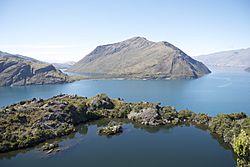Mou Waho facts for kids

View from Mou Waho, with Arethusa Pool in the foreground and The Peninsula in the distance
|
|
| Geography | |
|---|---|
| Total islands | 1 |
| Highest elevation | 473 m (1,552 ft) |
| Highest point | Tyrwhitt Peak |
| Administration | |
|
New Zealand
|
|
| Demographics | |
| Population | 0 |
Mou Waho is a special island found in Lake Wanaka, New Zealand. It's one of the biggest islands in the lake, similar in size to its nearby neighbor, Mou Tapu. This beautiful island is an important home for some of New Zealand's unique native animals.
Contents
Discover Mou Waho Island
Mou Waho is an island that stands out in the clear waters of Lake Wanaka. It's not just a piece of land surrounded by water; it's a vital part of the local ecosystem. The island is uninhabited by people, meaning no one lives there permanently. This helps keep it a safe haven for wildlife.
Location and Size
This island is located within the large and stunning Lake Wanaka. Lake Wanaka itself is in the Otago region of the South Island of New Zealand. Mou Waho is one of the two largest islands in this lake, making it an important landmark.
Wildlife on Mou Waho
Mou Waho is home to several interesting native animals. These creatures are a key part of New Zealand's natural heritage. Protecting them helps keep the island's ecosystem healthy and balanced.
Meet the Buff Weka
One of the most notable animals on the island is the buff weka. Weka are flightless birds native to New Zealand. They are known for being curious and clever. On Mou Waho, buff weka play a role in the island's food chain.
Other Native Creatures
Besides the weka, Mou Waho is also home to other unique creatures. These include mountain stone wētā and cave wētā. Wētā are large, spiky, cricket-like insects found only in New Zealand. You can also find Southern Alps geckos on the island. Geckos are small lizards known for their ability to climb.
Protecting the Animals
Sometimes, animals like the buff weka can be predators to other native wildlife. This means they might hunt smaller creatures like wētā and geckos. To help protect these smaller, more vulnerable animals, students from the local Mount Aspiring College took action.
Student Conservation Efforts
These students built 40 small wooden structures. They called these structures motels for the animals. These "motels" provide safe places for mountain stone wētā, cave wētā, and Southern Alps geckos to live. This project helps these native species thrive on Mou Waho Island. It shows how young people can make a big difference in conservation.

